Exploring April 2nd Birthstone: Diamonds and Their Significance
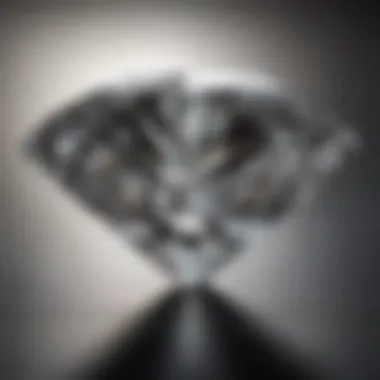
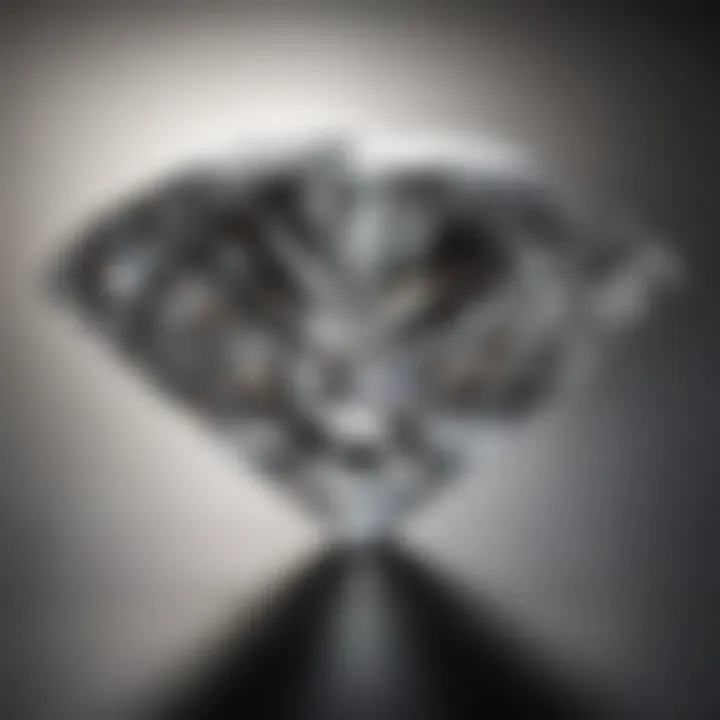
Intro
When you think of April, what often flickers in the mind are spring blooms, rebirth, and of course, diamonds. This precious stone, heralded as April's birthstone, is not just a symbol of luxury and elegance but carries a fascinating history and cultural significance that spans centuries. Whether glittering on an engagement ring or accentuating a necklace, diamonds tell a story of human endeavor, myths, and our quest for beauty.
In this article, we delve into the characteristics of diamonds, explore their historical journey, and examine how they’ve been perceived across cultures. With insights into selection and care, we aim to provide both new and seasoned gemstone enthusiasts with valuable knowledge about the allure of diamonds, particularly for those born on April 2nd.
Gemstone Overview
Definition and Characteristics
Diamonds, formed deep within the Earth's crust under intense heat and pressure, are a crystalline form of carbon. Their exceptional hardness makes them the hardest known natural material; this is often what attracts people to them for adornment. A diamond’s brilliance stems from its ability to reflect light—this optical dance gives rise to their intriguing sparkle.
Some key characteristics of diamonds include:
- Color: While most think of diamonds as colorless, they actually come in a spectrum of colors including pink, blue, yellow, and even black.
- Clarity: Refers to the presence of internal or external imperfections, known as inclusions or blemishes, respectively.
- Cut: The quality of a diamond's cut significantly influences its ability to reflect light; a well-cut diamond shines brilliantly.
- Carat: This measurement indicates a diamond's weight, thus impacting its overall value.
"Diamonds are not only a girl's best friend but also a fascinating puzzle of nature's craftsmanship."
Classification of Gemstones
Gemstones classify into two main categories: precious and semi-precious. Diamonds fall into the precious category, alongside sapphires, rubies, and emeralds. This classification isn’t just a matter of rarity and value; it helps identify a gem's intended use. Diamonds, due to their resilience and brilliance, have mainly been used in high-end jewelry, although their industrial applications for cutting tools cannot be overlooked.
Historical Significance
Ancient Uses and Cultural Importance
Dating back thousands of years, diamonds have always been prized. The earliest records trace them to India, where they were used as talismans for protection and strength. Ancient Hindus believed diamonds possessed mystical powers, warding off evil spirits. They were also associated with love and invincibility, a perception that hasn’t faded over time.
In various cultures, diamonds symbolize enduring love and commitment, which is why they often appear in engagement rings. In fact, the tradition of using diamonds in engagement rings took a notable turn after the 1938 advertising campaign by De Beers, framing them as essential for relationships.
Myths and Legends Surrounding Gemstones
Numerous legends surround diamonds, often attributing divine properties to this magnificent stone. For example, some believed that diamonds could cure ailments and provide the wearer with strength, while others saw them as symbols of power and victory. In medieval Europe, knights donned diamonds as a means to gain invulnerability in battle.
The weight of these stories contributes to the diamond's ethereal charm to this day, encapsulating the human fascination with gemstones.
Prelude to Birthstones
The study of birthstones speaks volumes about culture, tradition, and personal identity. Each stone, tied to a specific month, encapsulates unique qualities that resonate with people's experiences and beliefs. This article will explore the intricacies of birthstones, particularly focusing on April's birthstone, the diamond.
Understanding birthstones is not just about the gem itself; it's about the stories, emotions, and symbolism imbued within each gem. For enthusiasts, collectors, jewelry designers, and geology fans, the significance behind these stones enriches their appreciation and choice of jewelry. Birthstones have long been thought to bestow good luck, protection, or strengthen the wearer's traits. Thus, knowing these elements will enhance the value one places on these precious gems.
Understanding the Concept of Birthstones
Birthstones are more than mere ornaments; they represent a blend of history and significance. Each month of the year is associated with a specific gemstone that reflects its essence. It can be traced back to ancient civilizations, such as the Babylonians, who believed that wearing a birthstone during its designated month would grant special powers or good fortune.
For example, April is highlighted by diamonds due to their brilliance and rarity. In this way, the April birthstone holds a distinguished place, symbolizing strength, purity, and endurance. Collectively, these stones weave personal stories, connecting individuals to traditions of their heritage or community.
"A birthstone is a story waiting to be told; it speaks to the heart of those who wear it."
Historical Evolution of Birthstones
The evolution of birthstones is a rich narrative, intertwining with religious and spiritual beliefs across eras. Initially, birthstones were linked to the twelve stones worn by Aaron, the high priest in the biblical context. This artifact inspired the eventual semi-precious counterparts assigned to each month.
Over centuries, the list of birthstones saw alterations; various cultures adopted different stones based on regional significance or availability. In modern times, the American National Retail Jewelers Association established the official list, thus standardizing the concept for consumers.
Today, birthstones serve more than a historical purpose; they embody identity, connection, and customization in jewelry motives. Understanding their historical significance transforms how we perceive gemstones, especially the coveted diamonds of April.
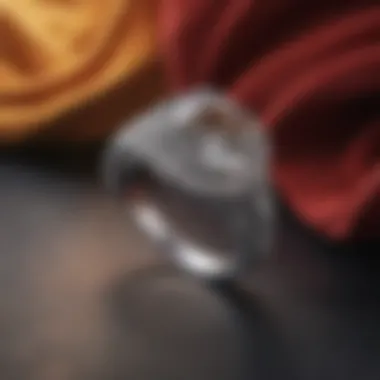
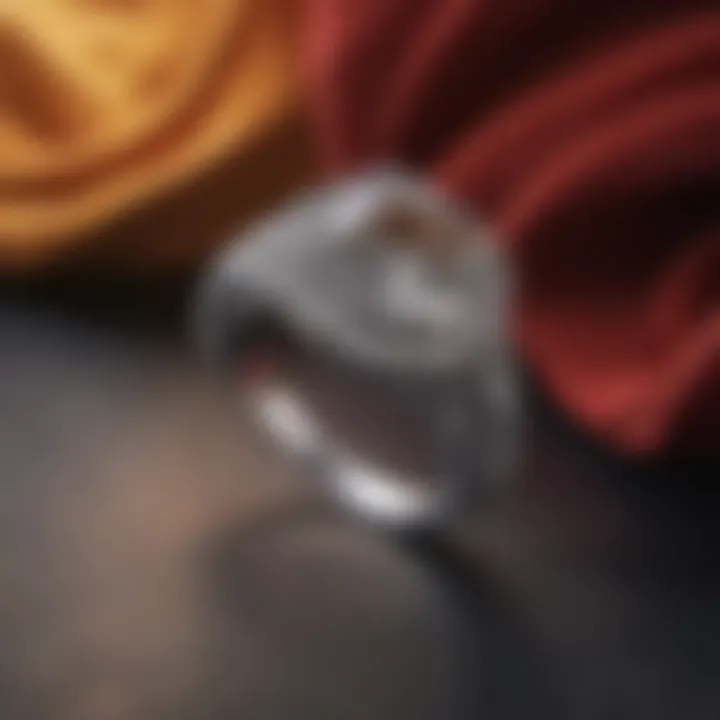
The Specifics of the April Birthstone
The birthstone for April is steeped in significance and allure, predominantly represented by diamonds. These precious stones have captivated hearts for centuries with their undeniable beauty and remarkable properties. Their importance transcends the allure of aesthetics; diamonds are woven into the very fabric of cultural practices and personal rites. This section will explore the distinctive features of the April birthstone, enriching the reader's understanding of its unique place in the world of gemstones.
Diamonds: The Birthstone of April
Diamonds are not just the hardest natural substance known to humanity but also possess a range of attributes that make them truly precious. Often referred to as a symbol of purity and mystery, their cultural importance is immense. They have been associated with love and commitment, often adorning engagement rings and other pieces of jewelry meant for significant occasions.
One notable aspect of diamonds is their formation. Created under extreme pressure deep within the Earth, they emerge through volcanic activity over millions of years. This natural process can sometimes lead to compromises in their crystal structure, resulting in various qualities ranging from flawless to included stones. This variability is fascinating and speaks to the unique history of each gem.
The diamond's brilliance is another reason for its veneration. Thanks to its high refractive index, it can reflect light in ways that few other materials can match. When cut well, diamonds can produce a sparkle, or "fire," that captures the eye and becomes a symbol of passion and commitment.
Beyond aesthetic appeal, diamonds carry a plethora of myths and legends. In ancient India, diamonds were believed to offer protection from evil forces, while in certain Asian cultures, they symbolize invincibility. This duality of beauty and power makes diamonds particularly attractive to collectors and enthusiasts.
"Diamonds hold more than mere monetary value; they encapsulate stories, emotions, and eras."
Other Associated Stones for April
While diamonds reign supreme as the April birthstone, there are other stones that carry significance for those born in this month. These stones, albeit less famous, offer alternatives that may resonate with certain individuals or symbolize personal attributes.
- White Sapphire: This gem serves as an excellent alternative to diamonds due to its aesthetic appeal and durability. White sapphires can exude similar brilliance, often at a fraction of the cost. Their clarity and hardness make them a desirable choice for engagement rings and other fine jewelry.
- Rock Crystal: Though not as commercially valuable, rock crystal is appreciated for its clarity and energetic properties. This crystal is believed to enhance one’s positive energy and clarity of mind, appealing to those who value metaphysical attributes.
- Moissanite: A relatively new contender in the gemstone market, moissanite exhibits a refractive quality surpassing even diamonds. Many have opted for this ethical alternative, which can also be found in beautiful colors beyond just the traditional white.
In understanding the April birthstone, it’s crucial to appreciate not just the primary gem, diamonds, but also the other stones that share this time of year. Each of these stones holds its own unique story, blending together to create a rich tapestry of symbolism, beauty, and significance.
In the subsequent sections, we will delve deeper into the physical properties of diamonds, exploring their formation, chemical characteristics, and the various factors that contribute to their desirability.
Physical Properties of Diamonds
Understanding the physical properties of diamonds is key when discussing their significance as the birthstone for individuals born on April 2nd. These characteristics not only contribute to the gem’s allure but also define its role in society. Diamonds have always been viewed as symbols of strength and beauty, partially due to their remarkable physical attributes. By comprehending these qualities, readers can appreciate the diamond’s enduring desirability, whether for adornment or investment.
Formation and Origin of Diamonds
Diamonds form under high-pressure conditions deep within the Earth’s mantle, typically around 100 miles beneath the surface. This natural process occurs over billions of years. Notably, the carbon atoms that make up diamonds undergo a crystallization process, transforming into a structure that is incredibly strong yet remarkably beautiful. Instead of mere geological phenomena, this transformation is a testament to nature’s artistry.
One fascinating aspect of diamond formation is the role of volcanic eruptions. These eruptions can transport diamonds closer to the Earth’s surface through a type of rock called kimberlite. Thus, while one might think of diamonds as merely precious stones today, their journey from the depths of the Earth to the jewelry counter is a dramatic saga marked by immense geological changes.
"Diamonds are a product of time, heat, and pressure, emerging as one of nature’s finest creations."
Chemical Composition and Attributes
The chemical makeup of a diamond is deceptively straightforward. A diamond is primarily composed of carbon atoms arranged in a crystal lattice formation. This structure contributes to several remarkable attributes:
- Hardness: Diamonds score a perfect 10 on the Mohs scale of hardness, making them the hardest known natural substance. This makes diamonds resistant to scratching and enduring over time.
- Thermal Conductivity: Diamonds excel at conducting heat, which is unique among gemstones. This property is why high-quality diamonds can be used in industrial applications beyond jewelry.
- Optical Properties: When light strikes a diamond, it refracts and reflects, creating the sparkle we see. The interplay of light offers a dazzling display, which is a central part of the diamond’s appeal.
Clarity, Cut, Carat, and Color
When assessing the quality of diamonds, four primary criteria are taken into account, famously known as the "Four Cs": clarity, cut, carat, and color. Here’s a closer look at each:
- Clarity: This refers to the presence of internal or external flaws, known as inclusions and blemishes. Higher clarity grades indicate fewer imperfections and hence a more valuable diamond.
- Cut: The cut determines how well a diamond reflects light. Various shapes like round, princess, and oval have different cut characteristics, impacting overall brilliance. A well-executed cut can significantly enhance a diamond's visual appeal.
- Carat: This is the weight of the diamond. Larger diamonds are rarer, so they typically command higher prices. However, carat alone doesn't determine value; a smaller diamond can be worth more than a larger one if it boasts better clarity or cut.
- Color: While many associate diamonds with a clear, colorless look, they actually come in shades ranging from colorless to light yellow or brown. Fancy-colored diamonds can fetch high prices depending on their hue and intensity.
Cultural Significance of Diamonds
Diamonds have been a source of fascination for centuries, not just for their breathtaking beauty, but also for the rich tapestry of cultural identities and myths surrounding them. In many societies, diamonds are much more than mere ornaments; they embody wealth, power, and eternal love. Their significance is layered and complex, often serving as symbols in various rituals, celebrations, and personal milestones.
Diamonds in History: Myths and Legends
Throughout history, diamonds have sparked the imagination and have been woven into numerous legends and stories. For instance, in ancient India, diamonds were believed to bring protection and good fortune, often adorning the crowns of royalty. The Hindus revered them as symbols of celestial bodies, associating their sparkle with the purity of the stars.
In Western cultures, tales of diamonds capturing souls or granting supernatural powers can be traced back to medieval times. One popular myth is that diamonds originated from the tears of the gods. This romantic notion enhances their status, as people often invest in diamonds for significant life events. From engagement rings to anniversaries, diamonds tell stories that transcend generations.
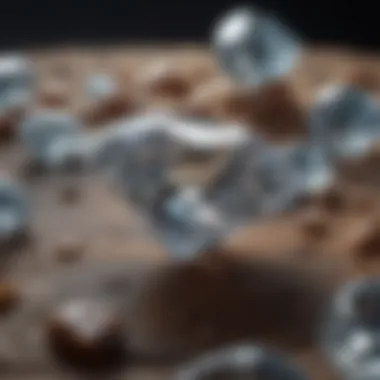

Another intriguing tale involves the famed Hope Diamond, said to carry a curse that befalls its owners. This legend has contributed to a mystique around diamonds that fascinates historians and collectors alike.
"Diamonds are not just gemstones; they are storied relics that carry centuries of tradition, passion, and belief."
Symbolism and Representation
The symbolism of diamonds can be quite profound. Universally, they are often associated with clarity, strength, and endurance. The hardness of a diamond represents the indestructible nature of love and commitment, which is why they are ubiquitous in engagement rings. The notion that diamonds last forever has turned them into a metaphor for eternal bonds.
Beyond personal relationships, diamonds also symbolize success and achievement. They are given as awards, like the famous Diamond Jubilee awarded in honor of remarkable accomplishments, echoing the stone's association with prestige and respect.
In contrast, some cultures have seen diamonds as emblems of excess and materialism. This duality reflects how diamonds can represent both aspiration and greed.
To further understand their cultural significance, consider these key points:
- Durability: Their hardness is often seen as a reflection of strength.
- Value: Considered a status symbol, they signify wealth.
- Romantic association: Commonly linked to love and commitment.
- Mysticism: Many cultures attribute spiritual properties to diamonds.
Thus, the cultural significance of diamonds cannot be understated. They go beyond mere ornamentation, becoming important elements that reflect human beliefs, dreams, and aspirations.
Diamonds in Modern Jewelry
Diamonds continue to reign as the pinnacle of luxury and elegance in today’s jewelry scene. Their sparkle and durability make them a popular choice for various types of adornments, ranging from engagement rings to statement pieces. In this section, we’ll explore the significance of diamonds in contemporary jewelry, the different types available, and the myriad customization options that allow individuals to express their unique tastes.
Types of Diamond Jewelry
The world of diamond jewelry is as vast as the ocean. Each piece carries its own charm and significance:
- Engagement Rings: Perhaps the most well-known type of diamond jewelry, these rings symbolize commitment and love. The tradition of diamonds as the focal point of engagement rings dates back to the 15th century, but it gained massive popularity in the early 20th century.
- Wedding Bands: Often designed to complement engagement rings, wedding bands carry deep sentimental value. They can be crafted solely from diamonds or combined with other gemstones.
- Earrings: From studs to elaborate chandelier designs, diamond earrings can elevate any outfit, whether for casual or formal occasions. They add a touch of sophistication while remaining versatile.
- Necklaces and Pendants: Diamond necklaces can range from simple solitaire pendants to intricate designs adorned with various gemstones. These pieces can act as show-stoppers and are often passed down as cherished heirlooms.
- Bracelets: Diamond-studded bracelets can make a bold fashion statement. Tennis bracelets, featuring a continuous line of diamonds, are a classic choice that brings a dynamic appeal.
Customization Options for Diamond Jewelry
Customization allows individuals to create jewelry that not only reflects personal style but also tells a story. Several options are available:
- Metal Choices: Gold, platinum, and white gold are common bases for diamond settings. Each metal has different properties and shades that can enhance or contrast the diamonds.
- Cut and Shape: The cut of a diamond influences how it reflects light. Common shapes include round, princess, oval, and cushion cuts. Selecting the right shape according to preference and the style of the jewelry can make all the difference.
- Setting Styles: The way a diamond is set can dramatically alter its appearance. Options include solitaire, halo, pave, and bezel settings. Each style can affect how light interacts with the gem, enhancing its brilliance.
- Gemstone Combinations: Incorporating colored gemstones alongside diamonds can create a captivating contrast. This trend is increasingly popular in personalized pieces, allowing for more creativity and individual expression.
- Engravings: Adding personal engravings can infuse emotional sentiment into jewelry, making it even more special. This might include initials, dates, or even short quotes that hold personal significance.
"Diamonds transform moments into memories, and customization turns those memories into timeless treasures."
In summary, diamonds hold a central place in modern jewelry, each type possessing its own unique value. Through customization, wearers can ensure their diamond pieces are distinct, mirrors of personal taste and sentiment. Whether it’s a wedding ring or an everyday accessory, understanding the available options makes the selection process all the more enriching and fulfilling.
Purchasing Diamonds: Key Considerations
When it comes to acquiring diamonds, especially those that fall under the banner of April's birthstone, becoming familiar with the nuances of purchasing is crucial. This segment is not just about aesthetics or pricing; it delves into various factors that determine the value and quality of these sought-after gems. Understanding these elements can save you money, ensure authenticity, and foster long-term satisfaction with your investment.
Evaluating Quality and Authenticity
The first step in your diamond-buying journey is to assess the quality and authenticity of the stone. Diamonds aren't just shiny rocks; they're graded based on four primary criteria—often referred to as the "Four Cs": Cut, Color, Clarity, and Carat weight. Familiarizing yourself with these aspects allows for a more informed decision.
- Cut refers to how well the diamond has been shaped and faceted. A well-cut diamond reflects light beautifully, making it sparkly.
- Color ranges from colorless to light yellow, with colorless stones being the most valuable.
- Clarity indicates the presence of internal flaws or inclusions. The less inclusions, the higher the value.
- Carat weight is a measure of how much a diamond weighs; larger stones usually command a higher price.
Additionally, one should always look for certificates from recognized grading institutions such as the Gemological Institute of America (GIA) or the American Gem Society (AGS). These documents not only affirm the authenticity of the diamond but also its quality grades. > Understanding these elements is key to making a wise purchase.
Choosing the Right Retailer
Selecting a trustworthy retailer is as critical as the evaluation of the diamond itself. Not all sellers prioritize integrity or transparency. Before making a purchase, consider the following:
- Reputation: Investigate the store or website thoroughly. Look for reviews online on platforms like Reddit or Facebook to see feedback from other customers.
- Certifications: Check if the retailer is affiliated with any reputable organizations, which can offer additional assurance of their reliability.
- Return Policy: A fair return policy can provide extra peace of mind. If something feels amiss after you leave the store, an easy return might just save you.
- Customer Service: Consider how you’re treated during your shopping experience. Knowledgeable staff who are willing to answer questions can make a substantial difference.
Investing some time into choosing a reputable retailer often pays off with a more satisfying buying experience and better returns down the line.
Investment Perspective on Diamonds
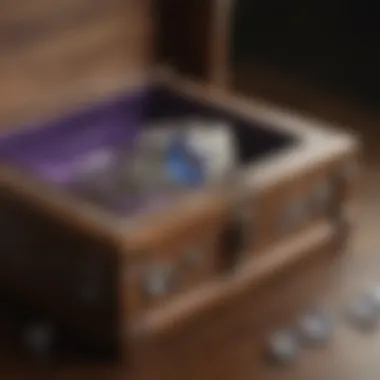

For many, purchasing diamonds is not merely a personal indulgence; it's also an investment. The market for diamonds can be as volatile as any financial market, and understanding the investment potential is essential. Here are some key points to ponder:
- Market Trends: Keep an eye on current market conditions. Diamond prices can fluctuate over time, so timing your purchase may lead to better deals.
- Rarity and Demand: Traditionally, certain diamonds hold their value better than others. For instance, rare colored diamonds often appeal to collectors and tend to appreciate over time.
- Long-Term Value: Diamonds generally retain their value well, but not all diamonds are created equal. Buying unique, high-quality stones can lead to better financial returns.
- Resale Potential: Understand the avenues of selling your diamond in the future. Whether through online platforms or auction houses, knowing how and where you can sell can impact your buying decisions.
Investing in diamonds requires both heart and strategy. Carefully considering these factors can give you a clearer roadmap toward making a successful purchase that stands the test of time.
Caring for Diamond Jewelry
Caring for diamond jewelry is more than just an aesthetic consideration; it’s crucial for preserving the beauty and integrity of these precious gems. Diamonds are celebrated not only for their dazzling appearance but also for their durability. However, even the hardest natural material can accumulate dirt, oils, and residues over time, diminishing its sparkle. Understanding how to properly maintain and care for diamond jewelry ensures that it remains in pristine condition for generations. It’s worth noting that a little diligence in care can save you from costly repairs or replacements down the line.
Cleaning and Maintenance Practices
Effective cleaning is paramount when it comes to maintaining the brilliance of diamonds. While these gemstones are robust, they can still be affected by everyday grime. A simple at-home cleaning routine goes a long way. Here’s what you can do:
- Soaking Solution: Create a cleaning solution by mixing warm water with a few drops of mild dish soap. Avoid harsh chemicals that can harm the metal setting.
- Gentle Scrubbing: Use a soft-bristle toothbrush to scrub the jewelry gently. Pay special attention to the areas around the diamonds and the settings where dirt builds up.
- Rinse and Dry: Rinse the piece in clean water to remove any soap residue, then dry it with a lint-free cloth. Make sure it’s completely dry before putting it away
- Professional Cleaning: Consider having your diamonds cleaned professionally at least once a year. Jewelers have tools and techniques that can restore even the dullest stones to their original luster.
"A well-cared diamond shines brighter than the rest; your jewelry deserves the same attention you give to your prized possessions."
Understanding Damage Prevention
A key aspect of caring for diamond jewelry involves preventing damage. While diamonds are tough, they’re not invincible. Awareness and precaution can help avoid mishaps that could chip or scratch your gemstones. Here are some key practices to keep in mind:
- Remove During Activities: Always take off diamond rings, bracelets, or earrings when engaging in activities that might expose them to impact or chemicals, like exercising, cleaning, or swimming.
- Proper Storage: Store diamond jewelry separately from other pieces. Using a soft pouch or a specialized jewelry box prevents scratching and damage from other pieces.
- Regular Inspection: Periodically inspect your jewelry for loose stones or damaged settings. An early catch can help you avoid losing a diamond altogether.
Maintaining your diamond jewelry isn't just about cleanliness; it’s also about safeguarding your investment and ensuring it remains a cherished part of your life. Taking the time to care for these gems pays off, allowing their extraordinary beauty to shine through effortlessly.
Diamonds in the Marketplace
The significance of diamonds in the modern marketplace transcends aesthetics alone; it's woven into the very fabric of economic and cultural values. As the birthstone for April, diamonds have carved a niche not just in jewelry but also in investment portfolios, which requires a keen understanding of both their market dynamics and intrinsic worth. This section aims to unpack the layers that constitute the diamond market, highlighting trends, consumer preferences, and the increasing importance of certified gemstones.
Current Market Trends
Understanding current market trends in diamonds is essential for anyone interested in these stunning gems. As society evolves, so do buying habits, and the world of diamonds is no exception. Recent years have seen a noticeable shift toward second-hand, vintage, and ethically sourced diamonds. Consumers are more conscientious than ever; they wish to ensure that their gems not only sparkle but come with a story—preferably one with a clean ethical slate.
In the realm of technology, lab-grown diamonds have been making waves. Offering a cost-effective alternative to mined diamonds, they also present an attractive avenue for environmentally concerned shoppers. Many jewelers are putting lab-grown options side by side with naturally mined diamonds, catering to a diverse clientele with differing values and budgets.
"The evolving diamond marketplace reflects societal changes, where consumer awareness and environmental considerations play a pivotal role in purchasing decisions."
This modern shift in purchasing habits has led to increased demand for transparent information from retailers, pushing them to disclose more about the origins and ethical aspects of their diamonds. Social media plays a key role in this transparency movement; platforms like Facebook and Reddit are buzzing with discussions on responsible purchasing and brand reputations. Customers are now open to sharing their experiences, influencing new buyers, and shaping market trends.
Role of Certified Gemstones in the Market
Certification of gemstones has become increasingly vital in the diamond marketplace. When it comes to investing in diamonds or purchasing them for sentimental value, buyers look for authenticity and quality assurance. Certification provides self-assurance; it ensures that the diamond you are about to buy has been evaluated by a reputable gemological lab. This certification verifies important aspects such as:
- Clarity: The inclusions and blemishes that determine a diamond's visual and market value.
- Cut: The overall craftsmanship and how well it reflects light.
- Carat Weight: A crucial factor in pricing.
- Color: From completely colorless to shades of brown or yellow, knowing this helps determine value.
The presence of independent certifications means that buyers can navigate the marketplace with more confidence. Organizations like GIA (Gemological Institute of America) are respected names in these circles, serving as benchmarks for quality.
When purchasing diamond jewelry, looking for certification is akin to buying a car with a clean title—it adds a layer of trust. In a market alive with options, this simple factor can help demystify the process, ensuring that consumers make informed choices. The more informed the buyer, the better the market becomes for everyone involved.
End
In wrapping up our exploration of diamonds as the April birthstone, it becomes clear that this gem is far more than just a sparkly adornment. The significance of diamonds stretches across history, culture, and modern practices, making them a vital point of interest for gemstone enthusiasts, collectors, and jewelry designers alike.
Summing Up the Importance of Diamonds as Birthstones
Diamonds carry a dual significance. On one hand, they symbolize emotional bonds and commitments, especially represented in the timeless concept of engagement rings. On the other hand, they serve as a representation of clarity and strength, often aligning with the birth month of April which is connected to renewal and vitality in many cultures.
"A diamond is not just a rock; it’s a piece of history, culture, and personal connection, making it invaluable."
The intricate nature of diamonds, with their geological origin and physical properties, adds considerable value to understanding why they are so highly sought after. Their composition consists primarily of carbon, yet the cutting and clarity can set apart a prized diamond from a less impressive one.
Furthermore, with the rise of customization in jewelry design, diamonds have transformed into individual statements as people choose to personalize their pieces using this exquisite stone. Choosing a diamond that resonates with personal taste adds a layer of significance beyond the typical associations.
However, potential buyers must also navigate the interwoven complexities of the diamond market today. From understanding quality metrics to recognizing ethical concerns over sourcing, each consideration plays a role in how one should approach diamond acquisition.







